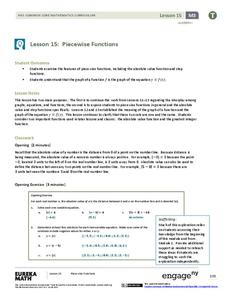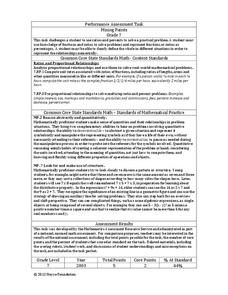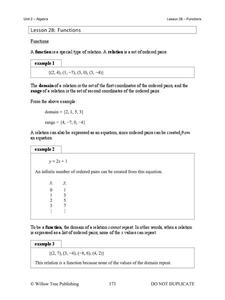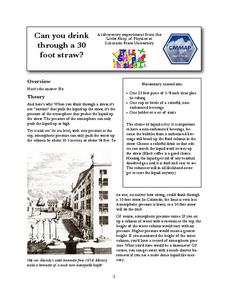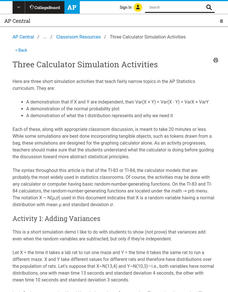Curated OER
Linoleum Reduction Print Quilts
Young scholars identify quilt designs along with the meanings and symbolism behind those designs. They explain the uses of a quilt and the controversial connection to the Underground Railroad.
Curated OER
Is That Fair: What is Fairness?
Students discover the meaning of fairness. In this character education activity, students create their own meanings of fairness and compare them to their classmates' definitions. The students discuss fairness in different situations.
Curated OER
Blanket the Plains
Students discuss vivid imagery in a story. In this figurative language lesson, students read samples of sensory language and then discuss the meaning of a piece of figurative language. Students provide examples.
Curated OER
How Did the Other Half Live?
Young scholars study the conditions under which immigrants lived. They determine what it means to make it in America. They observe the connection between immigration and unionization and how immigration changed the City of New York. They...
Curated OER
Using Old Maps as Tools to Explore Our World
Students explore historical maps. In this primary source analysis lesson plan, students uncover the meanings in selected historical maps as they use them to enhance lessons on historical events. Samples for classroom use are provided in...
Novelinks
Where the Red Fern Grows: Question Answer Response Strategy
What makes a good question? Middle schoolers explore the use of questioning through QAR, the question answer response strategy, while reading Where the Red Fern Grows. They learn about the four types of questions: right there, think and...
Curated OER
Connotation and Denotation: How Word Choice Affects a Paragraph
Review the terms denotation, connotation, diction, and mood in paragraph writing. After defining the terms, middle schoolers practice writing examples of both connotation and denotation. They complete a connotation and denotation graphic...
EngageNY
Piecewise Functions
Show your class members that if they can graph a linear function, they can graph an absolute value function. Groups create an absolute value graph using a table, then entertain the idea of an absolute value function defined as two pieces...
Noyce Foundation
Mixing Paints
Let's paint the town equal parts yellow and violet, or simply brown. Pupils calculate the amount of blue and red paint needed to make six quarts of brown paint. Individuals then explain how they determined the percentage of the brown...
Krzysztof Haft-Szatynski
Move the Turtle
Turtles are not known to be speedy movers, but have you ever tried to get them to move in a specific direction? How about getting them to move in a perfect circle? With this app, young computer programmers have to be on their toes to...
NASA
Discovering the Milky Way
What do you call a tiny collection of galaxies? A puny-verse! Young scholars graph data gathered by scientists studying Cepheids. They attempt to identify a relationship between the variables through standard and logarithmical graphing....
It's About Time
Speedy Light
We know the speed of light, but can we measure the speed of dark? During the lesson, scholars perform gedanken, or thought experiments related to the speed of sound and the speed of light.
Willow Tree
Functions
What makes a function a function? Learn the criteria for a relation defined as a function both numerically and graphically. Once young mathematicians define a function, they use function notation to evaluate it.
Teach Engineering
Seeing All Sides: Orthographic Drawing
How can your draw three-dimensional figures on paper? The lesson shows pupils how to draw orthographic projections of three-dimensional figures composed of cubes. After viewing a PowerPoint presentation, they practice this skill with...
Virginia Department of Education
Balanced
Bring balance to your lesson plans with an activity that asks individuals to solve one-step linear equations with inverse operations. Balance scales help learners understand the concept of isolating the variable.
Colorado State University
Can You Drink Through a 30 Foot Straw?
Drinking straws are a pretty simple device ... or, are they? Explore the possibility of sipping a beverage 30 feet away with an engaging activity that's sure to keep pupils guessing. Just place a long piece of plastic tubing in a glass,...
Houghton Mifflin Harcourt
Person to Person: English Language Development Lessons (Theme 4)
Help language learners understand words and cultural concepts. The second installment in a series of three language development lessons designed to accompany Theme 4: Person to Person helps bridge the gap for language learners by...
District 186 Springfield Public Schools
Tone, Mood, Theme, and Motif
It's all well and good when you're asked to identify a speaker's tone using his or her body language, facial expression, and pitch and emphasis. Identifying the tone of a written passage is another challenge entirely. Check out an...
College Board
Three Calculator Simulation Activities
Calculators sure come in handy. An AP® Statistics instructional resource provides suggestions for using calculator simulations. It gives activities for adding variances, normal probability plots, and t distributions.
Curated OER
Acrostic Poems: What's In a Name?
Young scholars find words that begin with the letters in their own names, using a variety of sources including word banks and online dictionaries. They create an acrostic poem. Pupils revise poems as needed, for meaning and...
Education World
End-of-Year Student Survey
Take the time at the end of the school year to learn from your youngsters about their experience in your class. Designed for elementary pupils, this survey asks students to comment on such elements as activities/lessons they did and did...
Curated OER
Introducation to Vocabulary for a Lesson about Communities
Young scholars practice using new vocabulary they learn about communities. In this communities vocabulary lesson plan, students use synonyms, context clues, and relevant content to unlock the meaning of new vocabulary words.
Curated OER
Reading Word Recognition, Fluency, and Vocabulary
Eleventh graders analyze words that derive meaning from Greek, Roman, and Norse myths. In this myth vocabulary lesson plan, 11th graders work in learning groups as visual learners, kinesthetic learners, and artistic learners to identify...
Curated OER
Applying Discourse Analysis in the
Learners investigate the use of discourse markers in context using a written film review. They infer meaning and correct usage of target language through context by means of inductive exercises.









